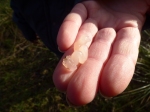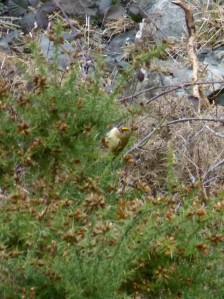Let’s Go Get Away
It being winter still in the middle of nowhere, we’ve had lots of snow flurries recently (and plenty of ice!). I was coming to the end of my contract at Radnorshire Wildlife Trust, and realised that I’d not visited the closest reserve to me – Werndryd. So as the snow started to fall outside the office window, I packed up my laptop and notebooks, drove back to the house. I swapped my work bits and pieces for more layers and two puppies, and we headed out. The light was fantastic, since it was between heavy snow flurries, and I saw a Great Spotted Woodpecker and two birds of prey – Red Kite and Buzzard. Werndryd wasn’t much – but it is mid winter! I admired the large pond and brash piles – they must both be absolutely buzzing with invertebrates in the warmer weather.
- Otter anal jelly?!
- Blurry Goldcrest from a distance
- Field Maple Tree – very old, but how old?
Back at the house, a walk around the large garden revealed something rather odd … pink, gelatinous, with a definite shape to it. Apparently it looks a lot like otter anal jelly. Yes you read that right … otter anal jelly. How lovely. And no-one seems to know why it’s produced, suggestions of *ahem* lubricant were offered. Well, indeed. Having seen a number of spraints on the stream, I know that it is indeed used by otters.
A brief interlude for Welsh wildlife occurred, when I made my way down to Dorset (and back again the same day!) for a job interview at Lulworth Cove. What a stunning place – I’ve visited before of course, having lived not too far away from it last year, and also on a school field trip. The geology of the place is just amazing – beds of rock that were horizontal are now pointing diagonally up at the sky. I’ve made a crude diagram below of some of the rock types there. Naturally, if I get the job, you can expect plenty more information on Lulworth Cove to appear in this blog!
- Snowy road
- Beautiful light across the snow
- Looking out to sea
I recently went over to Stanner Rocks and my head exploded. Not literally of course, but I went over with a local ecologist who knows the site well and I learnt so much how plants, geology, birds, and general natural history that I did feel my head was going to explode from all the knowledge I was trying to stuff into it.
NOTE: Should you wish to visit Stanner Rocks, there is very limited access due to the sensitivity of the plants and that the landscape can be quite hazardous. Contact National Resources Wales should you wish to visit I think.
- Plenty of Radnor Lily leaves
- Spiked Speedwell (Veronica spicata) – in bud in February!
The main reason we went there though was for the plants, as Stanner Rocks is a nationally important location for a number of rare plants and lichens. Whilst I went at an awful time of year for seeing the plants – they’re all very small at the moment, and zero flowers are about, at least I got to see them and know where to look for them if I can visit again later in the year.
- Lots of rarities in this little patch!
- Upright chickweed (Moenchia erecta)
- Rock Stonecrop (Sedum forsterianum)
- Liverwort sp
- Perennial knawel (Scleranthis perennis), looking very worse for wear
- The only distribution of some of the plants
- Cute photo of a little fungi
- Radnor Lily beginning to bud
- Stanner Rocks
- Stanner Rocks
- Unknown but potentially interesting liverwort
- Wood ants hill, will be absolutely buzzing come spring/summer
- Dew on Radnor Lily
- Unknown lichen
- Spiked Speedwell (Veronica spicata)
A lovely finish to the visit was a goldcrest flitting about in the bushes. It flew further away before I managed to get a photo, but the photo isn’t too bad considering it is a fast and constantly moving little bird, and about 60m away from me! A Peregrine Falcon also flew overhead, but I didn’t manage to get a photo of it. The ecologist I went with said that one had been in the trees just before I arrived, hopefully I can show you his photo in my next post!
Below are another few photos I wanted to include – the litter I picked up in a #2minutebeachclean when I was at Charmouth (see this blog post), some books that I’ve treated myself too, and the only wildlife seen on the camera trap I’ve recently put out: myself getting annoyed at the lack of otter spraint!
- Marine Litter at Charmouth
- Looking forward to getting stuck into these!
- Camera trap image






























Leave a Reply
Want to join the discussion?Feel free to contribute!